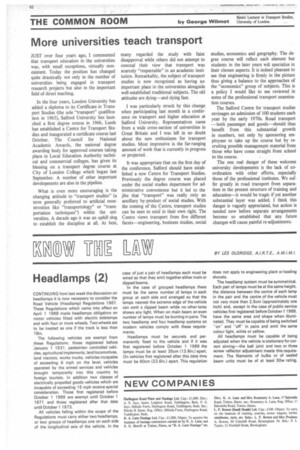ERITN nt'ff
Page 64

If you've noticed an error in this article please click here to report it so we can fix it.
BY LES OLDRIDGE, A.I.R.T.E, AM/MI.
Headlamps (2)
CONTINUING from last week the discussion on headlamps it is now necessary to consider the Road Vehicle (Headlamp) Regulations 1967. These Regulations which came into effect on April 1 1968 made headlamps obligatory on motor vehicles fitted with electric sidelamps and with four or more wheels. Two wheels are to be treated as one if the track is less than 18in.
The following vehicles are exempt from .these Regulations: those registered before January 1 1931. pedestrian controlled vehicles, agricultural implements, land locomotives, land tractors, works trucks, vehicles incapable of exceeding 6 mph on the level, vehicles operated by the armed services and vehicles brought temporarily into this country by foreign tourists. In addition two classes of electrically propelled goods vehicles which are incapable of exceeding 15 mph receive special consideration. Those first registered before October 1 1969 are exempt until October 1 1971 and those registered after that date until October 1 1973.
All vehicles falling within the scope of the Regulations must carry either two headlamps, or two groups of headlamps one on each side of the longitudinal axis of the vehicle. In the case of just a pair of headlamps each must be wired so that they emit together either main or dipped beams.
In the case of grouped headlamps there must be the same number of lamps in each group at each side and arranged so that the lamps nearest the extreme edge of the vehicle can emit a dipped beam while no other lamp shows any light. When on main beam an even number of lamps must be burning in pairs. The two headlamp and four headlamp systems on modern vehicles comply with these requirements.
Headlamps must be securely and permanently fixed to the vehicle and if it was first registered before October 1 1969 the lamps must be at least 35cm (13.8in.) apart. On vehicles first registered after this date they must be 60cm (23.6in.) apart. This regulation does not apply to engineering plant or loading shovels.
The headlamp system must be symmetrical. Each pair of lamps must be at the same height, the distance between the centre of each lamp in the pair and the centre of the vehicle must not vary more than 2.5cm (approximately one inch) and, except in the case of public service vehicles first registered before October 11969, have the same area and shape when illuminated. They must be capable of being switched "on" and "off" in pairs and emit the same colour light, white or yellow.
All headlamps must be capable of being adjusted when the vehicle is stationary for correct aiming—the ball joint and two or three screw reflector adjustment meets this requirement. The filaments of bulbs or of sealed beam units must be of at least 30w rating.








































































































